Transport and store chemicals
Added on 2023-04-21
31 Pages6396 Words264 Views
AHCCHM304
Transport and store chemicals
Assessment Guide
Questions assessed (please select) orally - Written
Candidate Name:
Assessor Name:
Workplace/RTO:
Conditions:(e.g.
On
or off the
job)
I declare this is
all my own
work Student signature
Date:
Transport and store chemicals
Assessment Guide
Questions assessed (please select) orally - Written
Candidate Name:
Assessor Name:
Workplace/RTO:
Conditions:(e.g.
On
or off the
job)
I declare this is
all my own
work Student signature
Date:
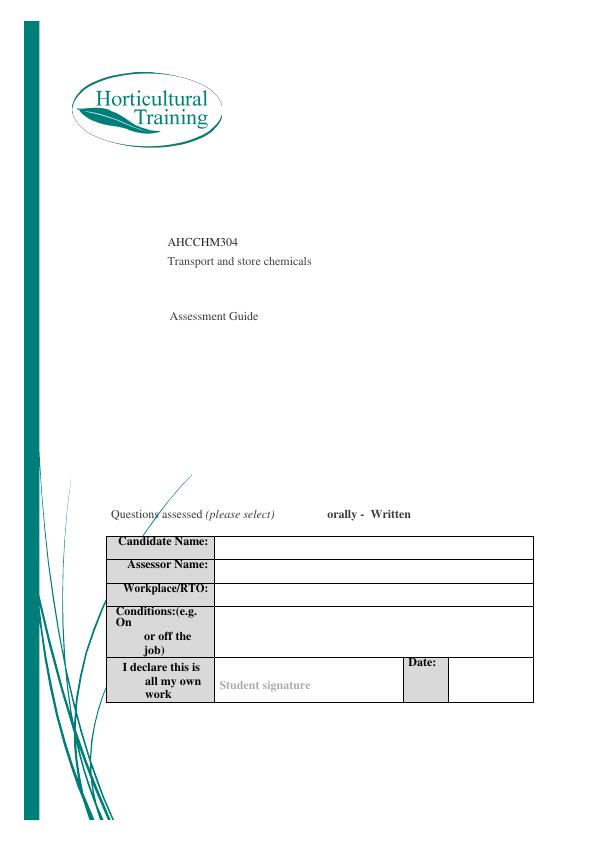
AHCCHM304 Transport and store chemicals
Horticultural Training Pty Ltd Page 2 Version 1
January 2017
This work is copyright © Horticultural Training Pty Ltd 2016
All rights reserved. This work is copyright, but permission is given to students to
make copies by photocopying or other duplicating processes for personal use within
their own workplace where training is being conducted by Horticultural Training Pty
Ltd. This permission does not extend to the making of copies for use outside the
immediate training environment for which they are made, nor the making of copies
for loan, hire or resale to third parties. For permission outside of these guidelines,
apply in writing to Horticultural Training Pty Ltd.
Written by: Trainer Leanne Jones January 2017
Horticultural Training Pty
Ltd PO Box 134
Strathpine Queensland 4500
Telephone: 07 3264 8613
Web:
www.horticulturaltraining.com.a
u Email:
admin@horticulturaltraining.co
m.au
Assessment Guide information
This Assessment Guide will assist you to build knowledge and skills towards a career in
the horticulture industry. It is a workbook that will be useful to you for recording your
learning and for presentation as evidence that you have completed the required learning
and practice activities.
Where it fits
This Assessment Guide relates to the Unit of Competency AHCCHM304, level 3 for the
horticultural industry. AQF is the Australian Qualification Framework. Level 3 is for staff
working unsupervised.
Recognition of current skills
If you can provide evidence that you already have the knowledge and skills covered in this
Training Guide, regardless of where they have been acquired, you can immediately apply for
assessment. Evidence may include reports, statements from training courses, references from
previous employers, photos, videos, practical demonstrations etc.
Assessment
The completed Assessment guide should be checked by your coach and trainer with your
results then recorded in your Competency Record Book. A Coach can be your employer,
supervisor, trainer, teacher or industry mentor. The Competency Record Book details your
knowledge, skills and work performance.
Workplace health and safety
Any work in the horticulture sector may be dangerous in some way. It is important to know
about your work health and safety procedures. As an employee you have a responsibility to:
• Follow your workplace’s work health and safety procedures
• Follow manufacturers guidelines for machinery and equipment
• Respond to a situation where someone is put at risk or injury (as long as you do not
endanger yourself)
• Report any incidents or situations which cause you or other people injury, or put you
Horticultural Training Pty Ltd Page 2 Version 1
January 2017
This work is copyright © Horticultural Training Pty Ltd 2016
All rights reserved. This work is copyright, but permission is given to students to
make copies by photocopying or other duplicating processes for personal use within
their own workplace where training is being conducted by Horticultural Training Pty
Ltd. This permission does not extend to the making of copies for use outside the
immediate training environment for which they are made, nor the making of copies
for loan, hire or resale to third parties. For permission outside of these guidelines,
apply in writing to Horticultural Training Pty Ltd.
Written by: Trainer Leanne Jones January 2017
Horticultural Training Pty
Ltd PO Box 134
Strathpine Queensland 4500
Telephone: 07 3264 8613
Web:
www.horticulturaltraining.com.a
u Email:
admin@horticulturaltraining.co
m.au
Assessment Guide information
This Assessment Guide will assist you to build knowledge and skills towards a career in
the horticulture industry. It is a workbook that will be useful to you for recording your
learning and for presentation as evidence that you have completed the required learning
and practice activities.
Where it fits
This Assessment Guide relates to the Unit of Competency AHCCHM304, level 3 for the
horticultural industry. AQF is the Australian Qualification Framework. Level 3 is for staff
working unsupervised.
Recognition of current skills
If you can provide evidence that you already have the knowledge and skills covered in this
Training Guide, regardless of where they have been acquired, you can immediately apply for
assessment. Evidence may include reports, statements from training courses, references from
previous employers, photos, videos, practical demonstrations etc.
Assessment
The completed Assessment guide should be checked by your coach and trainer with your
results then recorded in your Competency Record Book. A Coach can be your employer,
supervisor, trainer, teacher or industry mentor. The Competency Record Book details your
knowledge, skills and work performance.
Workplace health and safety
Any work in the horticulture sector may be dangerous in some way. It is important to know
about your work health and safety procedures. As an employee you have a responsibility to:
• Follow your workplace’s work health and safety procedures
• Follow manufacturers guidelines for machinery and equipment
• Respond to a situation where someone is put at risk or injury (as long as you do not
endanger yourself)
• Report any incidents or situations which cause you or other people injury, or put you

AHCCHM304 Transport and store chemicals
Horticultural Training Pty Ltd Page 3 Version 1
January 2017
or others at risk.
Equipment and materials to help you complete activities in this guide you will need
access to the following:
• A site where chemicals are stored
• Vehicles for the transport of chemicals
• SDS and labels for relevant chemicals and bio-agents
• PPE
Horticultural Training Pty Ltd Page 3 Version 1
January 2017
or others at risk.
Equipment and materials to help you complete activities in this guide you will need
access to the following:
• A site where chemicals are stored
• Vehicles for the transport of chemicals
• SDS and labels for relevant chemicals and bio-agents
• PPE
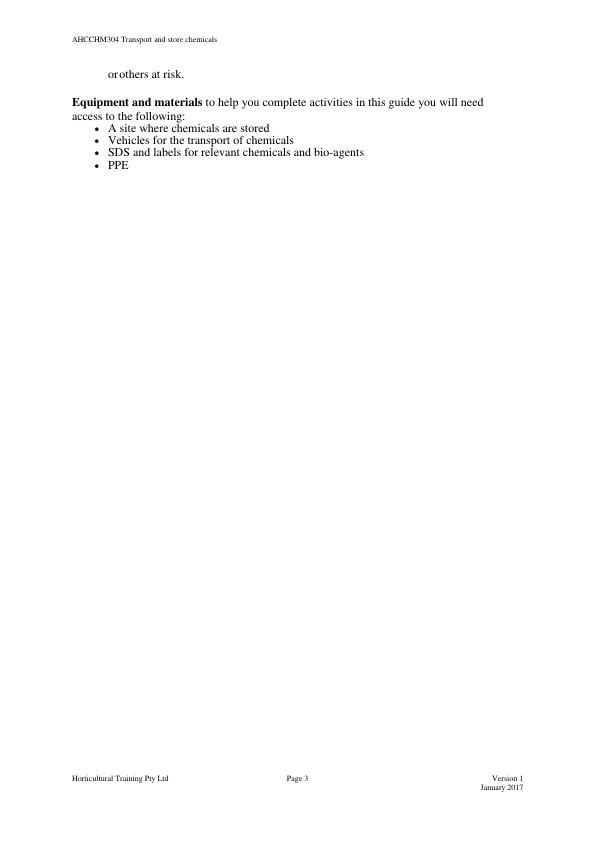
AHCCHM304 Transport and store chemicals
Horticultural Training Pty Ltd Page 4 Version 1
January 2017
Q1
List the hazards that may be encountered when transporting chemicals.
There are numerous perils involved when transporting hazardous materials. These include damage
in transit, loss and theft, fire and smoke, the risk of explosion, leaks and spills, and immediate or
delayed poisoning. Many goods are not dangerous themselves but contain harmful substances
which could cause harm to the environment, people or both.
PC (1.1, KA3)
Q2
Complete the following risk assessment for transporting chemicals.
Company/ Organisation:
Location:
Prepared by:
Date:
Hazard
Identificatio
n
Risk Assessment Control
Measures
Task /
Activity /
Hazard
Likelihoo
d Consequence Risk
Rating Use
Hierarchy of
control
Theft
medium Toxic effect if the
living systems are
exposed
Loss of money
6/10 Restrict labs to authorised
workforces, maintain inventory,
locking up of controlled substances
Spill/leak
High Chemicals can be
toxic, corrosive and
often explosively.
The effects of
chemical fates can be
lethal, for both
human beings and the
atmosphere.
8/10 1. Avoid breathing vapours.
2. Quickly identify the spilt substance
if you can do so carefully.
3. If the spill comprises a combustible
liquid, turn off all ignition sources if
you can do so safely.
4. Alert somebody in the space and
evacuate, locking all doors
(Dikshith, 2016).
Horticultural Training Pty Ltd Page 4 Version 1
January 2017
Q1
List the hazards that may be encountered when transporting chemicals.
There are numerous perils involved when transporting hazardous materials. These include damage
in transit, loss and theft, fire and smoke, the risk of explosion, leaks and spills, and immediate or
delayed poisoning. Many goods are not dangerous themselves but contain harmful substances
which could cause harm to the environment, people or both.
PC (1.1, KA3)
Q2
Complete the following risk assessment for transporting chemicals.
Company/ Organisation:
Location:
Prepared by:
Date:
Hazard
Identificatio
n
Risk Assessment Control
Measures
Task /
Activity /
Hazard
Likelihoo
d Consequence Risk
Rating Use
Hierarchy of
control
Theft
medium Toxic effect if the
living systems are
exposed
Loss of money
6/10 Restrict labs to authorised
workforces, maintain inventory,
locking up of controlled substances
Spill/leak
High Chemicals can be
toxic, corrosive and
often explosively.
The effects of
chemical fates can be
lethal, for both
human beings and the
atmosphere.
8/10 1. Avoid breathing vapours.
2. Quickly identify the spilt substance
if you can do so carefully.
3. If the spill comprises a combustible
liquid, turn off all ignition sources if
you can do so safely.
4. Alert somebody in the space and
evacuate, locking all doors
(Dikshith, 2016).
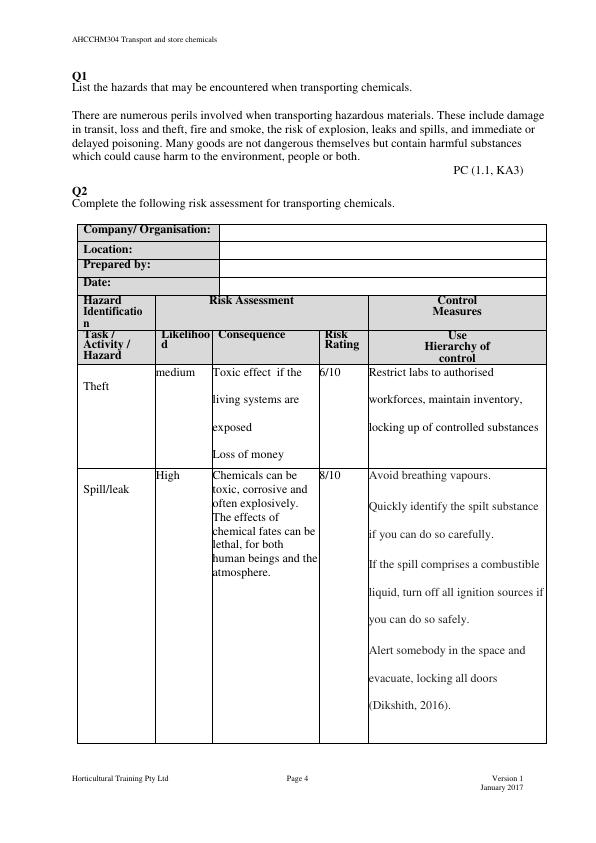
AHCCHM304 Transport and store chemicals
Horticultural Training Pty Ltd Page 5 Version 1
January 2017
Traffic
Accident High Due to the toxicity
and distribution of
dangerous chemicals,
these occasions not
only prompted
victims but also
contaminated the
environment, causing
extreme social fear
and traffic
difficulties.
8/10 Emergency evacuation after
hazardous chemical accidents is an
effective means to reduce harm
(Armour, 2016).
Person responsible for monitoring control measure
Name & Signature
Review date:
PC(1.1, CA7, 8, KA3)
Horticultural Training Pty Ltd Page 5 Version 1
January 2017
Traffic
Accident High Due to the toxicity
and distribution of
dangerous chemicals,
these occasions not
only prompted
victims but also
contaminated the
environment, causing
extreme social fear
and traffic
difficulties.
8/10 Emergency evacuation after
hazardous chemical accidents is an
effective means to reduce harm
(Armour, 2016).
Person responsible for monitoring control measure
Name & Signature
Review date:
PC(1.1, CA7, 8, KA3)
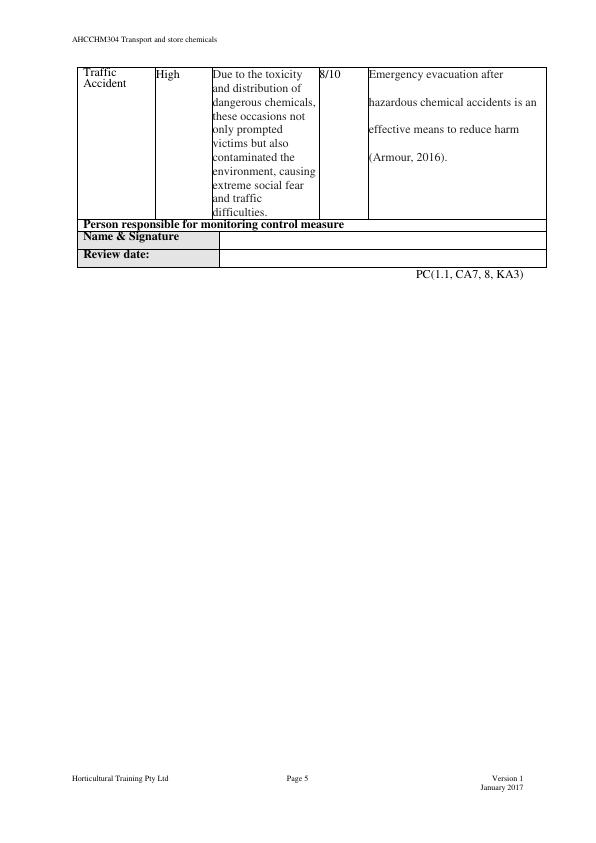
AHCCHM304 Transport and store chemicals
Horticultural Training Pty Ltd Page 6 Version 1
January 2017
Q3
Describe the procedures for the following;
a) Vehicle selection
Specific guidelines apply if one transit materials categorised as dangerous. The preliminary step is to
identify the hazards involved and classify the elements (Armour, 2016). One should then make sure
loads are safe, weight evenly distributed and one put appropriate warning indication on vehicles. If
one is transporting dangerous goods by road or rail, the following ought to be observed: use proper
packaging which is well labelled so that everybody in contact with it can take precise precaution
(Hemond & Fechner, 2014). Use an appropriate vehicle, container, tank or wagon according to the
classification of the materials displaying specific information. If required, about the goods on the car
or vessel follow proper procedures when products are being loaded and unloaded. Road vehicles
must carry specified types of safety equipment such as fire extinguishers. One may also need a
qualified dangerous goods safety adviser (Dikshith, 2016). All drivers must have suitable training,
not just to drive their vehicle, but also on what to do if an accident occurs.
PC (1.3)
b) Tie down:
Packages for dangerous goods, such as steel drums, plastics drums, plastics sacks, and boxes of
various kinds, are carefully designed and manufactured to ensure that the contents are entirely
contained under normal transport conditions. However, except for some packages for radioactive
materials and infectious substances, they are not designed to withstand accident conditions, such as
a high-speed collision, or overheating in a vehicle fire. It is therefore essential that the packages be
secured so that they do not fall off the vehicle, even in the event of a vehicle collision or overturn. It
is best achieved by carrying them in caged, closed or curtain-sided bodies. If not, they should be
well secured with load sheets, nets and straps. Tight stowage is also necessary to prevent friction or
chafing between packages during transport, which could lead to damage and leakage. It is essential
that packages are inspected before loading and those that show signs of damage or leakage should
not be loaded (Hemond & Fechner, 2014).
Horticultural Training Pty Ltd Page 6 Version 1
January 2017
Q3
Describe the procedures for the following;
a) Vehicle selection
Specific guidelines apply if one transit materials categorised as dangerous. The preliminary step is to
identify the hazards involved and classify the elements (Armour, 2016). One should then make sure
loads are safe, weight evenly distributed and one put appropriate warning indication on vehicles. If
one is transporting dangerous goods by road or rail, the following ought to be observed: use proper
packaging which is well labelled so that everybody in contact with it can take precise precaution
(Hemond & Fechner, 2014). Use an appropriate vehicle, container, tank or wagon according to the
classification of the materials displaying specific information. If required, about the goods on the car
or vessel follow proper procedures when products are being loaded and unloaded. Road vehicles
must carry specified types of safety equipment such as fire extinguishers. One may also need a
qualified dangerous goods safety adviser (Dikshith, 2016). All drivers must have suitable training,
not just to drive their vehicle, but also on what to do if an accident occurs.
PC (1.3)
b) Tie down:
Packages for dangerous goods, such as steel drums, plastics drums, plastics sacks, and boxes of
various kinds, are carefully designed and manufactured to ensure that the contents are entirely
contained under normal transport conditions. However, except for some packages for radioactive
materials and infectious substances, they are not designed to withstand accident conditions, such as
a high-speed collision, or overheating in a vehicle fire. It is therefore essential that the packages be
secured so that they do not fall off the vehicle, even in the event of a vehicle collision or overturn. It
is best achieved by carrying them in caged, closed or curtain-sided bodies. If not, they should be
well secured with load sheets, nets and straps. Tight stowage is also necessary to prevent friction or
chafing between packages during transport, which could lead to damage and leakage. It is essential
that packages are inspected before loading and those that show signs of damage or leakage should
not be loaded (Hemond & Fechner, 2014).
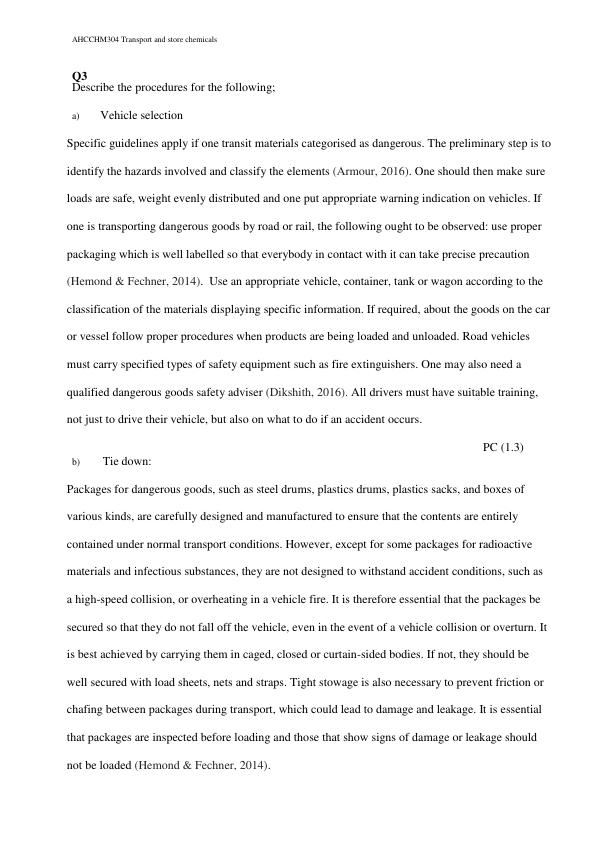
AHCCHM304 Transport and store chemicals
Horticultural Training Pty Ltd Page 7 Version 1
January 2017
Use the right tie-downs to secure your loads. The first step in ensuring a load begins with tie-downs
such as straps, ropes, or chains. Weight and gravity alone will not hold items in place. A cargo bar
buttresses against the sides of the truck bed, helping to prevent things from sliding or tipping.
PC (1.4)
c) Spill response
Avert the spread of dirt and vapours
If possible neutralise acids and bases
Regulate the range of the liquid
Absorb the liquid
Collect and contain the clean-up remains
Dispose of the wastes
Decontaminate the area and affected equipment.
PC (CA2)
d) Emergency response:
Abandon the structures as directed to do so by the emergency group.
March quickly and quietly to the gathering area or as directed by the emergency personnel.
Wait in the assembly field in groups.
Remove anything remaining in the mouth. Unless a victim is unconscious, having a seizure, or
cannot swallow, give about two ounces of water to drink. Call the poison centre. Do not try to
neutralise a poison by giving; raw eggs, salt water, mustard, vinegar or citrus fruit juices as an
antidote or to cause vomiting.
PC (CA2)
e) Injury / poison:
Remove anything remaining in the mouth. Unless a victim is unconscious, having a seizure, or
Horticultural Training Pty Ltd Page 7 Version 1
January 2017
Use the right tie-downs to secure your loads. The first step in ensuring a load begins with tie-downs
such as straps, ropes, or chains. Weight and gravity alone will not hold items in place. A cargo bar
buttresses against the sides of the truck bed, helping to prevent things from sliding or tipping.
PC (1.4)
c) Spill response
Avert the spread of dirt and vapours
If possible neutralise acids and bases
Regulate the range of the liquid
Absorb the liquid
Collect and contain the clean-up remains
Dispose of the wastes
Decontaminate the area and affected equipment.
PC (CA2)
d) Emergency response:
Abandon the structures as directed to do so by the emergency group.
March quickly and quietly to the gathering area or as directed by the emergency personnel.
Wait in the assembly field in groups.
Remove anything remaining in the mouth. Unless a victim is unconscious, having a seizure, or
cannot swallow, give about two ounces of water to drink. Call the poison centre. Do not try to
neutralise a poison by giving; raw eggs, salt water, mustard, vinegar or citrus fruit juices as an
antidote or to cause vomiting.
PC (CA2)
e) Injury / poison:
Remove anything remaining in the mouth. Unless a victim is unconscious, having a seizure, or
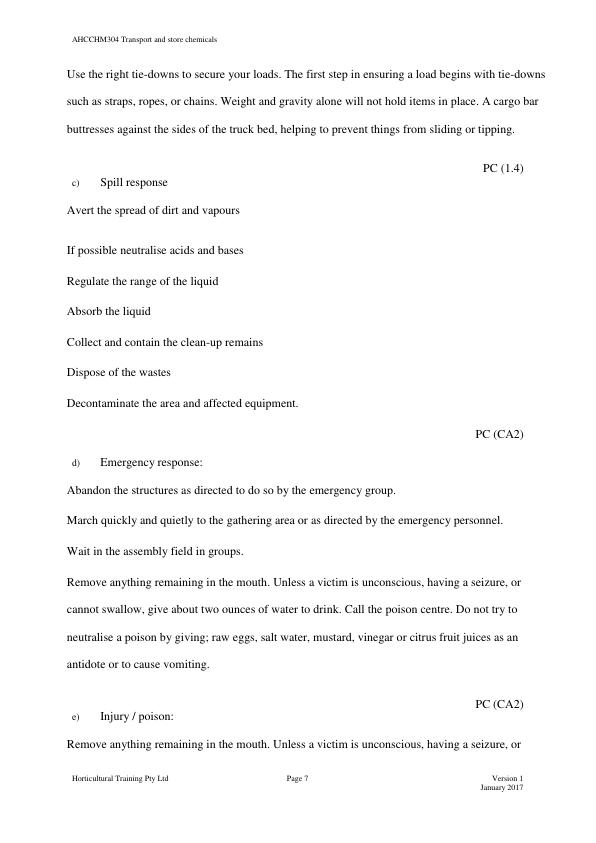
AHCCHM304 Transport and store chemicals
Horticultural Training Pty Ltd Page 8 Version 1
January 2017
cannot swallow, give about 2 ounces of water to drink. Call the poison centre. Do not try to
neutralise a poison by giving; raw eggs, salt water, mustard, vinegar or citrus fruit juices as an
antidote or to cause vomiting. If the person vomits, turn his or her head to the side to prevent
choking. Start CPR if the body shows no signs of consciousness, such as moving, breathing or
coughing.
In case of injury
Get operators to a safe area. Do not risk other losses, and move any injured worker away from a
dangerous area.
Assess the situation
Call help centre and assist the injured
Gather information and keep evidence
PC (KA3)
f) Location of SDS:
Have stock identifiers ready, such as product name and code. Try to find the name of the business.
Go on the website of the producer of the commodity. Once one is on the producer's website, see if
they have a part where they have their MSDSs/SDSs free to the people. One can then explore over
their MSDSs/SDSs and determines the one for your goods.
If one bought the product from a seller and did not receive the SDS on the producer's website, go on
the distributor's website to know if they make MSDSs/SDSs free for the commodities that they offer
and market.
If one still has not found the SDS of the product, go to specific websites that store SDSs and allow
to search and download a certain number of SDSs for free. Reach to the producer or distributor of
the merchandise directly and inquire the SDS if one has still not found it.
PC (1.7)
g) Transportation log books:
Established chemical logbooks enhance the ability to track the chemicals in case of safety incident.
Horticultural Training Pty Ltd Page 8 Version 1
January 2017
cannot swallow, give about 2 ounces of water to drink. Call the poison centre. Do not try to
neutralise a poison by giving; raw eggs, salt water, mustard, vinegar or citrus fruit juices as an
antidote or to cause vomiting. If the person vomits, turn his or her head to the side to prevent
choking. Start CPR if the body shows no signs of consciousness, such as moving, breathing or
coughing.
In case of injury
Get operators to a safe area. Do not risk other losses, and move any injured worker away from a
dangerous area.
Assess the situation
Call help centre and assist the injured
Gather information and keep evidence
PC (KA3)
f) Location of SDS:
Have stock identifiers ready, such as product name and code. Try to find the name of the business.
Go on the website of the producer of the commodity. Once one is on the producer's website, see if
they have a part where they have their MSDSs/SDSs free to the people. One can then explore over
their MSDSs/SDSs and determines the one for your goods.
If one bought the product from a seller and did not receive the SDS on the producer's website, go on
the distributor's website to know if they make MSDSs/SDSs free for the commodities that they offer
and market.
If one still has not found the SDS of the product, go to specific websites that store SDSs and allow
to search and download a certain number of SDSs for free. Reach to the producer or distributor of
the merchandise directly and inquire the SDS if one has still not found it.
PC (1.7)
g) Transportation log books:
Established chemical logbooks enhance the ability to track the chemicals in case of safety incident.
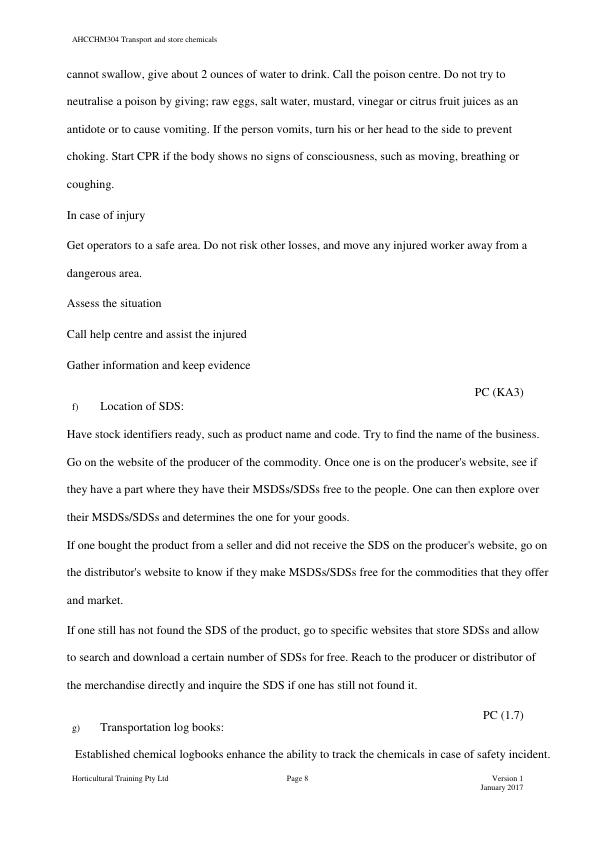
End of preview
Want to access all the pages? Upload your documents or become a member.
Related Documents
AHCCHM303 Prepare and apply chemicalslg...
|34
|6714
|196
Control Weeds - Assessment Guidelg...
|34
|8767
|361
Impacts of Sociological Factors Essaylg...
|28
|8073
|268
HLTWHS002 Follow Safe Work Practices for Direct Client Care Assessment Workbooklg...
|38
|5637
|232
Developing workplace communication strategies Participant Workbook CHCCOM003 PW Moodle CHC51015 V1.0 CHCCOM003 Develop workplace communication strategies Participant Workbook CHCCOM003 PW Moodle CHC51lg...
|76
|11192
|92
CHCECE002 Ensure the Health and Safety of Children: Assessment 31823B/01lg...
|26
|5496
|117
